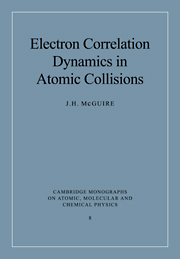Book contents
- Frontmatter
- Contents
- Preface
- 1 Introduction
- 2 Single electron transition probabilities
- 3 Formulation of multi-electron transition probabilities
- 4 Independent electron approximation
- 5 Statistical methods
- 6 Correlated multi-electron electron transition probabilities
- 7 Perturbation expansions
- 8 Projectiles carrying electrons
- 9 Reactions with photons
- 10 Relations between charged particle and photon reactions
- Appendices
- References
- Index
2 - Single electron transition probabilities
Published online by Cambridge University Press: 11 September 2009
- Frontmatter
- Contents
- Preface
- 1 Introduction
- 2 Single electron transition probabilities
- 3 Formulation of multi-electron transition probabilities
- 4 Independent electron approximation
- 5 Statistical methods
- 6 Correlated multi-electron electron transition probabilities
- 7 Perturbation expansions
- 8 Projectiles carrying electrons
- 9 Reactions with photons
- 10 Relations between charged particle and photon reactions
- Appendices
- References
- Index
Summary
There are, in general, many possible transitions of electrons in atoms. In some processes of practical interest more than one electron may undergo a transition. Such multiple electron transitions are the topic of the next and subsequent chapters. In this chapter the simpler topic of single electron transitions is considered, where the activity of a single electron in an atom is the focus of attention. Even this relatively simple case may be impossible to fully understand if the electron of interest is influenced by other electrons in the atom. So in this chapter the interdependency of electrons in the system is ignored. That is, the electrons are treated independently. Typically, such an independent electron is regarded as beginning in an initial state characterized by some effective nuclear charge ZT and a set of quantum numbers n, l, m, s, ms from which all possible properties (e.g., energy, shape, magnetic properties, etc.) may be determined. Interaction with something else, (usually a particle of charge Z and velocity, v), may cause a transition to a different final state of the atom.
The simplest transition occurs in interaction of atomic hydrogen with a structureless projectile. There are various ways to evaluate the transition probability for such a system. Exact calculations usually require use of a computer. Approximate calculations may be done more easily. Calculations for many electron systems are often done approximately using single electron transition probabilities.
- Type
- Chapter
- Information
- Electron Correlation Dynamics in Atomic Collisions , pp. 16 - 56Publisher: Cambridge University PressPrint publication year: 1997



